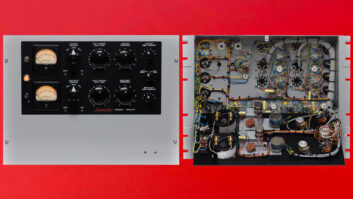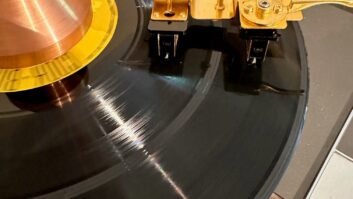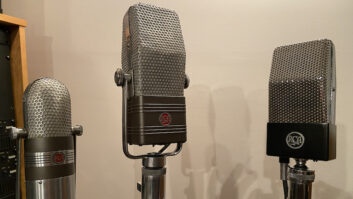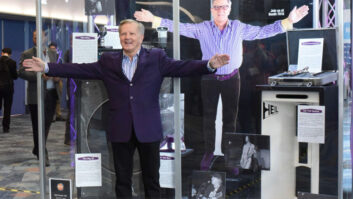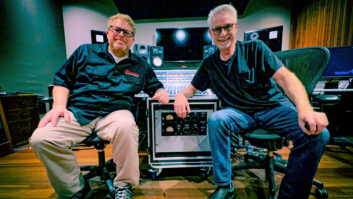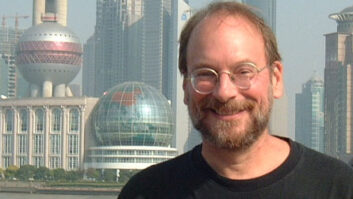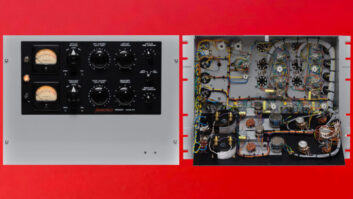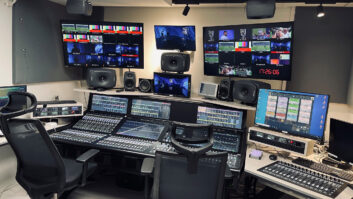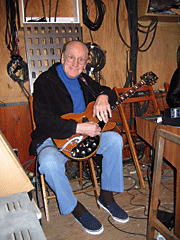

“I’ve just made a decision,” announces Les Paul, circa 1949. “I’m through with electronics. No more electrical gadgets for me.” Paul, apparently, isn’t very good at keeping his word.
photo: Courtesy Marc Ursell, Fran Cathcart, Bob Cutarella
Those words, taken from a vintage recording of The Les Paul and Mary Ford Show radio program, helped launch Les Paul & Friends, Capitol’s new tribute to the veteran guitarist and recording pioneer, who celebrated his 90th birthday this past June. The album features a who’s who of popular music from the ’60s through the ’80s, including Eric Clapton, Sting, Jeff Beck, Neal Schon, Billy Gibbons, Richie Sambora, Steve Miller, Mick Hucknall, Joe Perry, Keith Richards and others.
The disc takes a novel approach to the standard tribute album, which usually features other artists performing or dueting with the guest of honor on his own catalog. “There was a period of music that Les, as a player, missed during the ’60s, ’70s and ’80s,” explains co-producer Bob Cutarella. With the exception of a pair of award-winning albums with Chet Atkins made in the late ’70s, Paul had, for all intents and purposes, retired in 1964. “It was right around the time Bob Dylan plugged in his electric guitar,” says Fran Cathcart, the album’s other co-producer and an engineer for a good portion of the sessions. “He was kind of on the sidelines watching Jimi Hendrix, Led Zeppelin and all of that happen. So we decided we wanted to do something with him that would be inclusive of all that he missed.” The album is filled with great guitar-oriented songs from the period and new recordings of a few Paul standards to round things out.
Paul has been playing for years on Monday nights at New York’s Iridium Jazz Club, mostly performing his old repertoire. “He was interested in our idea because he kind of wanted to go back to school a little bit and learn some new things — try playing rock music,” says Cathcart. “A change in music is good,” Paul says. “The fact that so many players are playing so many different ways today is good, too.”
Les Paul at his home studio (Mahwah, N.J.) with producer Fran Cathcart
As for the song selection and artist matchup, says Cutarella, “It morphed a lot. We decided if you had great songs from the ’60s and ’70s — identifiable songs — you had a shot at introducing Les to a new audience. We weren’t going for the 13 to 25 demographic — that wasn’t going to happen. So we decided to make an organic record with some organic songs. And, of course, put technology in there because Les is the father of technology. Let him play with technology, wherever possible, and just pick great songs that would be fitting of certain artists.”
Paul left the song choices to the producers — a rare move for a mostly self-produced artist. “I figured they would be more in tune with what would be commercially appealing,” Paul says. “If I had picked them, I might have done ‘Ode to Billie Joe’ or ‘(Sittin’ on) The Dock of the Bay.’ The artists still had a choice of doing their own songs if they liked, with no obstacles. I think it worked out great that way.”
Each song’s backing tracks were recorded first, sometimes with the guest artist playing live with the band, with Paul’s overdubs added at a later date at his home in rural Mahwah, N.J. Two sets of sessions were held with, basically, two core sets of veteran backing musicians: one in L.A. and one in New York.
The L.A. band mostly comprised Abe Laboriel Sr. on bass and Hiram Bullock on guitar, with drums switching between Abe Laboriel Jr., Vinnie Colaiuta and Kenny Aronoff. Keyboards were handled by Lou Forestieri and Greg Mathieson, with additional guitars by Steve Lukather, Kenny Wayne Shepherd and, occasionally, producer Cathcart. The New York lot featured Bullock with bassist Will Lee, Shawn Pelton on drums and Brian Mitchell on keyboards. “It actually shuffled around a little bit, deliberately,” explains Cutarella. “We wanted Nathan East, for instance, for bass on Jeff Beck’s track [“Good News”] because they just click.”
Eastside Sound’s four-mic setup for vocals: RØDE K2, RØDE NT2000, Neumann U87/67 hybrid and AEA R92 (top) at Capitol Records
The Los Angeles sessions, which comprised almost two-thirds of the rhythm tracks, were held over three weeks in February of this year at — where else — Capitol Studios in Hollywood. “Les actually helped design these studios back in 1955, ’56, along with the famous echo chambers,” notes Rob Christie, supervising A&R producer for Capitol-EMI. “I reviewed the drawings and offered my input into the studio design,” Paul says. Aside from little things like a missing echo chamber and a lack of AC outlets in the studios proper, Paul recalls pointing out one important feature to label president Glenn Wallichs, which had apparently been overlooked in the famed round building’s design. “I told him, ‘Looks good to me. The only thing is, where do you put a broom?’”
The New York sessions were held at Eastside Sound, co-owned by Cathcart and the studio’s original owner, Lou Holtzman. (The facility closed its original location in 2000 after 28 years of business, reopening at its present spot a few blocks away in September 2003.) Engineering for the L.A. sessions was handled, for the most part, by Cathcart, who shifted more to the co-producer role once the work moved east, with engineer Marc Urselli picking up the reins there.
The producers’ biggest challenge was assembling the impressive collection of guest artists in a timely fashion. “We had a time constraint, so we had to take advantage of whatever opportunities afforded themselves to us,” Cutarella explains. “We had people out here for the Grammys, for instance, which made a perfect chance to grab Jeff Beck and people like that.” Adds Cathcart, “We basically had to get 14 artists, which was the original plan, playing with Les, and we had two-and-a-half months to do it, from start to finish. So we just worked with the artists’ schedules; when they were in town, we worked with them.”
Eastside Sound Studios’ guitar collection
The artists were eager to show their wares in Paul’s honor. “They seemed like they just wanted to impress Les,” Cutarella says. “I remember Neal Schon coming in and saying, ‘I love Les! I just want to show Les what I can do.’” Of course, many guitarists’ trademark guitars went out the window in favor of cherished Gibson Les Pauls. “Billy Gibbons showed up with this beautiful Les Paul,” recalls Cathcart. “He didn’t bring in the fuzzy white Gibson Explorer or whatever that thing is he usually plays! Richie Sambora had a rare ’59 Les Paul, as did Steve Lukather.”
For miking, the team took advantage of Capitol’s incredible inventory of classic gear. “We used all the toys here,” says Cathcart, “the Fairchilds and all the rare items. And they have [Neumann] U67s — I looked over in the corner and there was a milk crate filled with them — that’s how many they have. If those mics could talk!” Guitars were typically fed through two amplifiers to get a variety of sounds. “We’d put a [Shure] 57 up close, typically off-axis, so that it wouldn’t be quite as bright and harsh. Then we might have a U67 four or five feet away or more for an overdub to capture as much of the wonderful rooms at Capitol as possible.”
Eastside’s mic collection offered the producers many choices, as well. For vocals, Urselli used the AEA R92 ribbon (which was also used on some guitar amps) and the RØDE NT2000, with its variable pattern, and a RØDE K2 tube mic. “For artists Alsou, Bullock, Buddy Guy and Beth Hart, we set up those three mics,” Urselli says. “It was always best to have a number of mics set up; we would pick and choose later which ones we liked the best. And on some, we ended up using a blend of a few microphones” during mixing later at Eastside.
The studio also has a modified 1977 Neumann U87 incorporating a custom conversion by InnerTUBE Audio. “The warmth and smooth punch of the converted 87 wins when compared with the stock U87,” says Eastside’s Holtzman. In addition, Eastside relies upon the services of German microphone-modifying engineer Peter Drefahl. “Peter does incredible work on all vintage microphones. One of our favorites is a Neumann/Gefell U57 totally rehabbed and outfitted with his solid-state multipattern power supply,” Holtzman says.
co-producer Fran Cathcart (left), Billy Gibbons and co-producer Bob Cutarella (right);
While some artists, such as Sting and Clapton, sent in their contributions from abroad, the sessions afforded Cutarella and Cathcart the experience of a lifetime, working with an incredibly diverse collection of musicians. Edgar Winter sang “Rock and Roll, Hoochie Koo” at Capitol Studio A and played sax on “69 Freedom Special” before, after a casual mention from Cutarella, recording a version of his “Dying to Live” with the band. “It was amazing,” Cutarella recalls. “The guy that wrote that song so long ago, he still has his chops and he just blew it down in one take.” (The song is expected to appear as a bonus track in one release configuration or another.)
For Frampton’s “So Into You,” the team recorded a backing track in L.A., which, as it turned out, wasn’t used. “That was one song where we did take after take, and it just didn’t provide the artist the kind of framework for him to succeed with the song,” says Cathcart. “We played it for Peter and he decided to re-record it with us in New York, playing all of the rhythm guitar parts himself. Then he took the files to his home in Ohio and overdubbed some more.” Frampton was also coaxed into performing on another artist’s track. “He was in the same day as Johnny Rzeznik, who was there to record U2’s ‘All I Want Is You,’” recalls Cutarella. “He had nothing to do, so we just asked him to get in there and play, and he didn’t have a problem with it.”
Most challenging, engineering-wise, were two tracks featuring the late Sam Cooke: “(Somebody) Ease My Troublin’ Mind” and “Good News,” which feature Clapton and Beck, respectively. Cathcart and Urselli took the original 3-track recordings of the two songs, owned and supplied by ABKCO Records, and, in Pro Tools, time-stretched each bar to provide the backing band an even tempo to record to. The original stereo track was then EQ’d to roll off the low end as much as possible to allow the musicians to clearly hear Cooke’s original vocal (and some percussion to assist in timing).
Another historic — and unexpected — recording also appears on the disc. Before a new version of Steve Miller’s “Fly Like an Eagle” (recorded separately by Miller and his band), a five-year-old Miller is heard talking with his godfather — Paul — who, after hearing the young boy walking about the yard singing, correctly prophesies, “Steve, you’re really gonna go places.” “That was recorded in 1949 at Bertha and George Miller’s house in Milwaukee,” Paul recalls. “I never knew George was going to record the thing.”
Buddy Guy’s guitar setup;
Of all the album’s overdubs, however, none was as important as the ones by the master himself. The recording was done, as mentioned, at Paul’s home. “He never really has worked in studios anyway,” notes Cutarella of Paul, who is known for recording everywhere but a studio. “He did come to the studio in New York and just said, ‘You know, I’d really like you guys to come out to the house and we’ll put it together that way.” And like a true musician, Paul got somewhat of a late start each day. “He doesn’t get up till four in the afternoon!” Cutarella says. Age, of course, can also affect one’s attempt at playing rock ‘n’ roll. “I have arthritis in my hands, which makes it difficult,” says Paul. “It just requires a new way of thinking.”
Although Paul has a Tascam MX-2424 SE digital recording system, Cathcart brought a G4 laptop with Pro Tools, connected via a Digi 002 Pro Tools interface and patched into Paul’s API board for monitoring. Paul took advantage of the opportunity to try all the latest gizmos (including a Line 6 Vetta II digital modeling amplifier), though none seemed to surprise him. “Every time we’d show him something, he’d look at it for a while and say, ‘I invented that!’” says Cutarella.
The trick for Paul was to come up with guitar parts that would fit neatly into the existing recordings. According to Paul, “I would listen to the track and say, ‘Okay, now the question is, I could play a lot of different things there, but which is the thing that’s going to marry to it the most? What can I do to enhance it? Maybe nothing.’” Notes Cutarella, “There are some bits you’ll hear just classic Les Paul on there, and other times he’s just playing some guitar chinks.”
On the album, Paul made a point of allowing his guests to be the ones shining. “I think a lot of times,” notes Cathcart, “he kind of looked at what was going on with these younger musicians, and said, ‘This is about what I’ve done to enable them to do what they did. I’m going to sit back and watch what they’re doing, and I’m going to contribute and play rhythm guitar and just marvel at all that’s come out of my multitrack recording and electric guitar.’”
Paul agrees. “When you find the picture, then you find the thing that fits the picture. Otherwise, you’re adding something just to be there and that’s not the answer. The answer is, don’t get in the other guy’s way — you want to make him the star. All I am is the frame around the picture.”

Les Paul (left) at his home studio with producer Bob Cutarella
Engineer Marc Urselli at work
From L to R: Producer Bob Cutarella Les Paul and producer Fran Cathcart
One of the many different guitar setups used by guitarist Hiram Bullock at East Side Sound Studios: Gibson Les Paul Standard, a Marshall JCM 2000 DSL 401 amp and an AEA R92 ribbon mic
